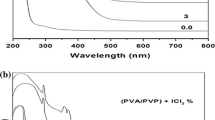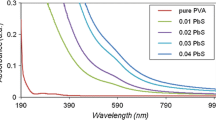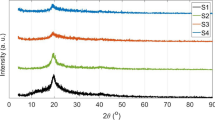Abstract
The present investigation is about the synthesis and structural characterization of polyvinylchloride (PVC)–polyamide (PA) blend. PVC and PA were mixed in different proportion, i.e., 70:30 and 60:40, and final sample in the form of films of ~40 μm was peeled out from the dried dip-coated glass slides. Prepared films were characterized using Fourier transform infrared (FTIR) and UV–visible spectroscopy. Formation of new bands was observed in the FTIR spectrum of PVC with the increase of PA’s percentage in composition, which confirms the presence of guest polymer in the prepared blend. UV–visible analysis indicated the change in optical band gap with variation of PA’s composition in PVC/PA blend.
Access this chapter
Tax calculation will be finalised at checkout
Purchases are for personal use only
Similar content being viewed by others
References
Huang J, Turner SR (2018) Hypercrosslinked polymers. Polym Rev 58:1–41
Luo SC (2013) Conducting polymers as biointerfaces and biomaterials. Polym Rev 53:303–310
Kamal MS, Sultan AS, Al-Mubaiyedh UA, Hussain IA (2015) Review on polymers flooding: rheology, adsorption, stability, and field applications of various polymer systems. Polym Rev 55:491–530
Safarpour M, Oskoui SA, Khataee A (2020) A review of two-dimensional metal oxide and metal-hydroxide nanosheets for modification of polymeric membranes. J Ind Eng Chem 82:31–41
John G, Nagarajan S, Vemula PK, Silverman JR, Pillai CK (2019) Natural monomers: a mine for functional and sustainable materials-occurrence, chemical modification and polymerization. Prog Polym Sci 92:158–209
Primo GA, Igarzabal CLA, Pino GA, Ferrero JC, Rossa M (2016) Surface morphological modification of crosslinked hydrophilic co-polymers by nanosecond pulsed laser irradiation. Appl Surf Sci 369:422–429
Liao Y, Loh CH, Tian M, Wong R, Fane AG (2019) Progress in electrospun nanofibrous membranes for water treatment: fabrication, modification and applications. Prog Polym Sci 77:69–94
Ferreira DP, Cruz J, Fangueiro R (2019) Chapter-1—Surface modification of natural fibers in polymer composites. In: Green composites for automotive applications, pp 3–41
Sangroniz L, Drongelen M, Cardinaels R, Santamaria A, Peters GWM, Muller AJ (2019) Effect of shear rate and pressure on the crystallization of PP nanocomposites and PP/PET polymer blend nanocomposites. Polymers 186:121950
Kaur M, Kaur R, Samra KS (2017) Luminescent behavior of semiconductor doped polyamide. AIP Conf Proc 1860:020004
Ren X, Meng N, Yan H, Bilotti E, Reece MJ (2019) Remarkably enhanced polarizability and breakdown strength in PVDF-based interactive polymer blends for advanced energy storage applications. Polymers 168:246–254
Liu Y, Zhou C, Li F, Liu H, Yang J (2020) Stocks and flows of polyvinyl chloride (PVC) in China: 1980–2050. Resour Conserv Recycl 154:104584
Taha TA, Azab AA (2019) Thermal, optical and dielectric investigations of PVC/La0.95Bi0.05FeO3 nanocomposites. J Mol Struct 1178:39–44
Rajesh, Kaur D, Gaur MS, Goyal P, Tiwari RK, Rogachev AA, Rodachev AV (2019) Measurement of AC and DC relaxation properties in polyvinyl chloride (PVC) nanocomposites. Measurements 135:323–332
Cao Q, Yuan G, Yin L, Chen D, Wang H (2016) Morphological characteristics of polyvinyl chloride (PVC) dichlorination during pyrolysis process: influence of PVC content and heating rate. Waste Manage 58:241–249
Wang L, Zhu Q, Bai Y (2019) Synthesis and characterization of a series of water-soluble polyamides and their micellization behavior. Polymer 179:121634
Lu P, Zhao Z, Xu B, Li Y, Wang Y (2020) A novel inherently flame-retardant thermoplastic polyamide elastomer. Chem Eng J 379:122278
Nguyen PH, Spoljaric S, Seppala J (2018) Redefining polyamide property profiles via renewable long chain aliphatic segments: towards impact resistance and low water absorption. Eur Polymer J 109:16–25
Ramesh S, Leen KH, Kumutha K, Arof AK (2007) FTIR studies of PVC/PMMA blends based polymer electrolytes. Spectrochemica Acta A 66:1237–1242
Chang C, Liou G, Hsiao S (2006) Highly stable anodic green electrochromic aromatic polyamide: synthesis and electrochromic properties. J Mater Chem 17:1007–1015
Author information
Authors and Affiliations
Corresponding author
Editor information
Editors and Affiliations
Rights and permissions
Copyright information
© 2023 The Author(s), under exclusive license to Springer Nature Singapore Pte Ltd.
About this paper
Cite this paper
Roy, J., Samra, K.S. (2023). Optical Behavior of Polyvinylchloride–Polyamide Blend. In: Prakash, C., Singh, S., Krolczyk, G. (eds) Advances in Functional and Smart Materials. Lecture Notes in Mechanical Engineering. Springer, Singapore. https://doi.org/10.1007/978-981-19-4147-4_16
Download citation
DOI: https://doi.org/10.1007/978-981-19-4147-4_16
Published:
Publisher Name: Springer, Singapore
Print ISBN: 978-981-19-4146-7
Online ISBN: 978-981-19-4147-4
eBook Packages: EngineeringEngineering (R0)




